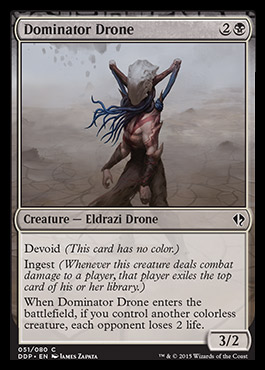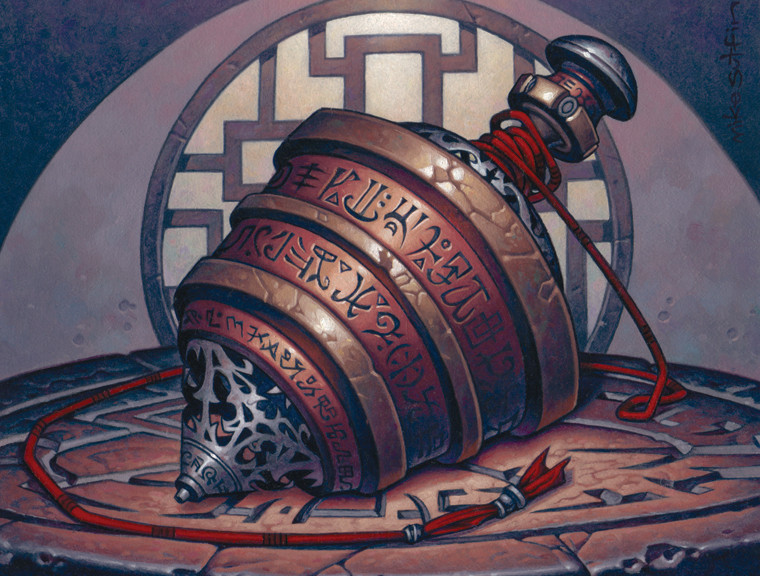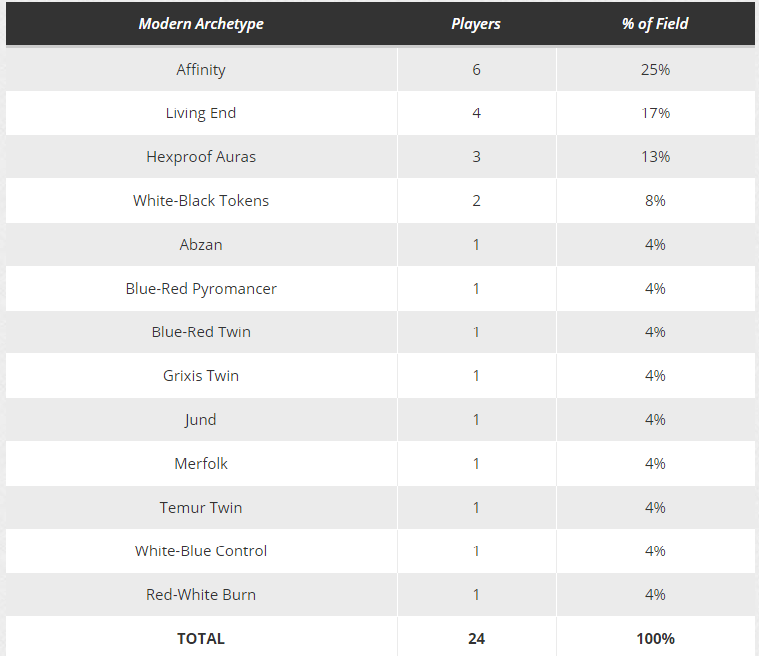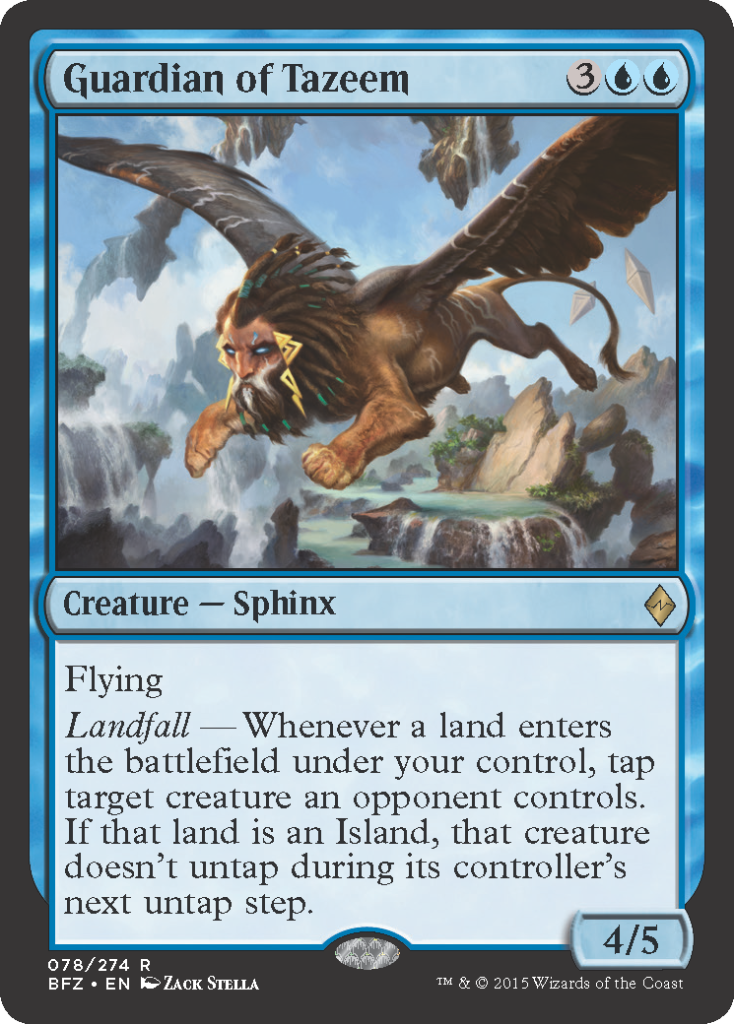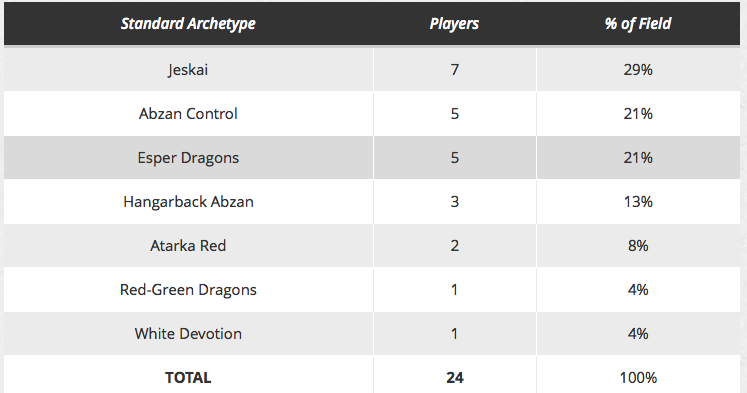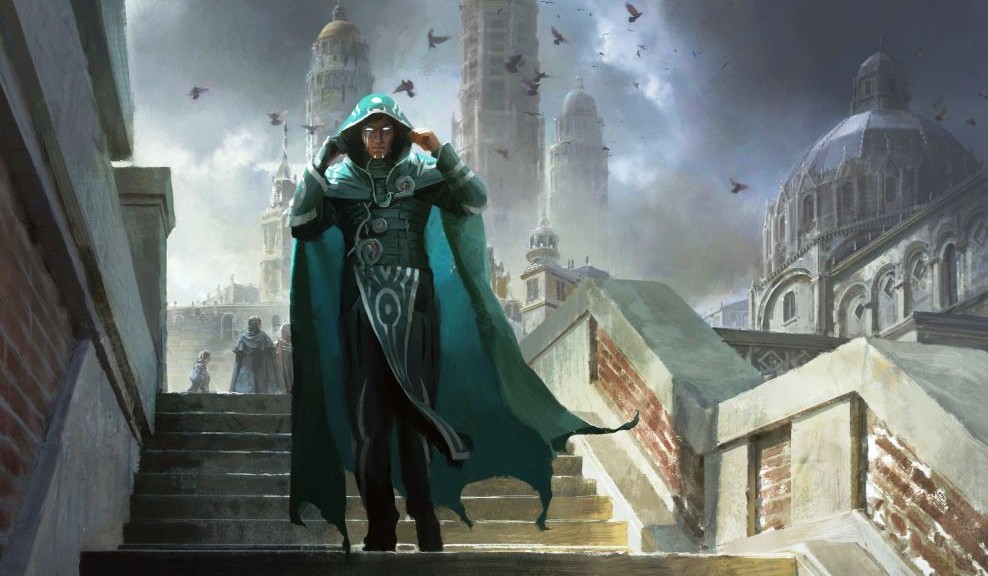The full set has now been spoiled. Check the blog area of the site this week for in-depth reviews of each color by members of the MTG Price writing staff. Thanks for reading our spoiler coverage!
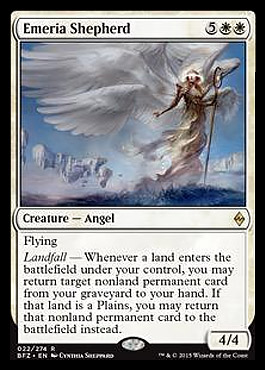
Jason Alt: They waited until the last possible second to spoil a card I actually like. This card is absolutely SICK in a deck with Endless Horizons, Knight of the Reliquary and other green and white landfall-enablers. Basically, my article from this week. This goes in right the hell in that deck and I love it. I think this may be too slow for Standard until Khans block rotates. This is sicko in EDH and I hope it sucks in Standard so I can grab these cheap.
DJ Johnson: I think this is a bulk rare, but wow is it a powerful one. You get soo much disgusting value out of this, and the difference between a Plains and non-Plains here is just massive, as opposed to 1 damage, a single +1/+1 counter, or making their guy not untap. This brings back planeswalkers, Ulamogs, other copies of itself…. This is value-town. I don’t think it sees play in Standard, but I want a full stock of these at all times to sell to EDH players, and then later I’ll buy more out of collections for dimes. This card will be a cheap, but powerful EDH staple, a la Prophet of Kruphix/Deadeye Navigator.
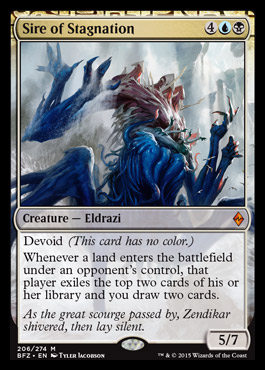
Jason Alt: I’ve seen this called the closest thing we’re going to get to Consecrated Sphinx. That may be true, but this doesn’t cause the issues that both players having a Sphinx caused. This punishes them for landfall and gives you exiled cards that you can process with other eldrazi and keeps your hand full. This is a very UB card and I imagine if you’re playing any Eldrazi, you’re likely playing this one. Most of the rares in this set are pretty bad and once we get to redemption, I think the lack of Expedition Lands on MODO means redemption will be down, putting upward pressure on prices. This is a $10 card preorder on eBay and I don’t know if it can maintain that price, short of being played in a lot of decks.
DJ Johnson: $10 pre-order price makes me very averse to buying in right now. The card design is awesome, and I think it’s going to see some decent play in EDH for those who can’t afford a Consecrated Sphinx. It will probably go down to $3-4, and then I’d feel fine trading for them or buying them for your EDH/Cube. I don’t think Standard play is likely, but we’ll see.
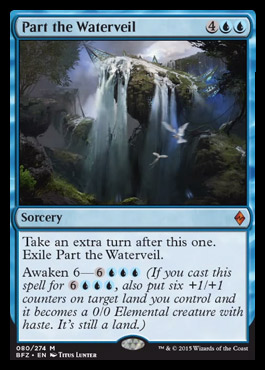
Jason Alt: This is hard to evaluate. EDH players make up the bulk of people who are casting Time Warp and they made this go from $5 in Standard to closer to $15 now. This could take some pressure off of Time Warp but it’s not nearly as good. This is another copy for players with decks like Narset who don’t care how much the spell costs. $5 for a rare in Standard is hard to translate to a mythic, but this costs 6, not 5 and that may be prohibitive. I don’t know. Time Warp was fringe Standard playable before. This is a $6 preorder and that may be OK. Other than Greenwarden, there is no reason why this card exiling itself matters a ton in Standard so this is probably $5 or less in Standard and EDH may boost it a bit, but this is no Time Warp. The Awaken isn’t the kind of upside we care about in EDH.

Jason Alt: How’d you like to tap all of your mana so that you can also tap all of your creatures? That’s how we win games, right? Fight-murdering their utility dorks is cool, but this pulls your pants down unless you can kill all of their creatures, survive an alpha strike with tapped dudes or if you have so many more creatures that you still have blockers after you use this. You know, when you’re already winning. I hate win-more cards. This breaks a groundstall sometimes, though, although it’s risky. I feel like I’d hate this even without it being restricted to just colorless creatures. Fighting is useful but I don’t know if that pushes this over bulk.
DJ Johnson: Buuuuuuuuuuuuulk rare. Bulkiest of the bulk rares. Cards can’t get more bulky than this. Seriously, this is worse than most of the uncommons.

Jason Alt: I want to say a vampire deck will materialize but all of the vampires are 6 mana except for the good one. That means this or the other 6-drop will be the presumptive curve-topper and almost all of the deck will have to be uncommons and commons if it materializes at all. Why give us powerful vampires but no lord and not enough of them for a deck? Still, even though this is a 6 mana, if you can get through with a few creatures, dropping a Polluted Delta with this in play is probably GG.
DJ Johnson: Another bulk rare. I really wish this gave itself the power buff in addition to all of your other creatures, because it’s so damn easy to kill. This screams “Intro Pack rare”, so don’t buy these for less than a quarter. Bulk rare.

Jason Alt: Drana lost her vampire powers but became a powerful beater. This is worthy of being legendary and mythic and it’s one of the few “I have to hit them with this creature” creatures I like. You can put on a clinic about first strike damage and how much it screws up combat math with this. I doubt we’ll have enough vampires for a vampire tribal deck (maybe more in the next set?) but this could be in an allies deck or just a “I attack with creatures” deck. This will make your weenies bigger and it grows itself, too, making it formidable. Being Mythic means it can be worth a few bucks but being legendary means that effect is dampened. I don’t want this as an EDH general and Tiny Leaders isn’t an actual thing so I wouldn’t worry about that propping this up. All in all, I liked the other Drana better but this is a real card and it just needs a deck to be anywhere from $5-$10.
DJ Johnson: I’m biased, and I love this card. It goes straight into Marchesa, and fills out my curve very well. I loooove this card. Financially though? Not a fan. I don’t think it’ll fit into a black aggressive deck in any high numbers enough to be a chase mythic. Vampire casual will give it a little bit of demand, but I still wouldn’t pre-order. $4 seems safe a couple months out, you can wait. I’ll wait until I grab one at buylist price to jam it into Marchesa.

Beastcaller Expert
1G
Creature – Elf Shaman Ally
Haste
T: Add 1 mana of any color to your mana pool. Use this mana only to cast creature spells.
Jason Alt: You’d think hanging out with a Lotus Cobra might have taught this dude a thing or two about being a mana dork. We’re never getting a Birds of Paradise equivalent again, are we? We just get lame knockoffs like this. Is this better than Rattleclaw Mystic? In some decks. It’s also worse than Arbor Elf in some decks. I imagine this will see a grudging degree of adoption and may hurt some of the people who speculated on Rattleclaw Mystic as this lets Abzan be Abzan. Still, the whole point of creatures like this is to give us 3 mana on turn 2, not 1 mana on turn 2. I hate this, but I don’t think me hating it is enough for it to not see play. It’s at least better than the new Hierarch.
DJ Johnson: Yeeech. Not a fan. I’m happy that this doesn’t threaten Rattleclaw Mystic’s chance at being worth dollars, although maybe this sees some play. Who do I look like, someone who knows Standard? I’m calling it a near-bulk rare, but not a pure bulk rare. Hold onto your Rattleclaws, don’t let this steer you off course.

Jason Alt: Yesterday, DJ said the uncommons in this set are better than the rares. I tend to agree. This is an actual good card, especially if you play EDH. If Crucible of Worlds weren’t $45 I’d buy a bunch. This card is stupid in a deck with Life from the Loam and it’s stupid in Limited and it’s just stupid. I bet control tries to play this. This will be a buck or two which is more than we can say for most of the stupid rares in this stupid set. Such good uncommons. I love this card.
DJ Johnson: Now this could fit into my Child of Alara deck. I play Crucible and Loam with Exploration and several other extra land effects, so this is a way to draw a bunch more cards late game. I’d rather pull these than most of the rares, because these will be a solid $.50-$1, because they can also see play in Standard as a 1-2of. This cycle is going to be awesome.

Jason Alt: This scales off of other allies but doesn’t grant them any bonuses? That’s kind of disappointing. What kind of captain is that? Your other allies also have to attack to grant her the bonus. If it’s even 2 or 3, it’s a significant boost and with the evasion you can likely deal them quite a bit of damage even if the other creatures get blocked and die. Still, this doesn’t feel like an ally or an angel or a captain. The problem with 5 mana allies is they won’t likely be a 4-of so a non-4-of in one deck only means the upside is very limited.
DJ Johnson: And here we have the… what is this, the 7th ally that costs 5 mana? How many of these do we actually expect to see play? How often does the aggro deck play a five drop without haste at the top of the curve? Buuuuulk rare.

Jason Alt: People have demonstrated they will pay 1UU for a counterspell with upside. If that upside is exiling the countered spell, people are OK. People are even OK paying 1UU for a counterspell that lets them scry. Are we OK with it if the upside is an additional mode rather than a bonus for paying 1UU for the spell? I think they will be. Paying 6 mana for a counter late and getting a 3/3 elemental out of it may be worth it, especially if you can always just cast the spell for 1UU. There is no pricing data on this, yet, but this feels like if the presale price is under $2 there is an opportunity to make money, here. If this gets played, it likely gets played in multiples and that helps its upside.
DJ Johnson: As of 6:15PM EST on 9/15/15, this is sold out on SCG for $1.99 pre-orders. People want this card. Like Jason said, Dissolve and Dissipate were perfectly playable non-rares in Standard, and this is a massive tempo swing if you can pay the six mana. I don’t think it’s a $5 rare once the set actually hits shelves for a couple of weeks, but buying these for $2-3 to play with opening weekend seems perfectly fine.

Jason Alt: They made a worse Skinrender a rare? You likely can’t even use this on turn 3 because how will they have an exiled card? So basically this being cheaper doesn’t even matter because you can’t use it any earlier. Someone disagree with me, please. I think this is bulk.
DJ Johnson: This card is bad. It’s really bad. I used to pod into Skinrender in Standard, and I wouldn’t pod into this. Seriously, why is this a rare? Just because it’s a processor? Ulamog’s Nullifier is a processor too, but at least you got a solid power and toughness for the rate.

Jason Alt: This is amazing. Being Sorcery speed may be what keeps it from getting played in Standard, but if we get a slow enough format to tap out for something like this, this is the best 5 mana draw spell we have seen. If you have a dragon or big artifact or enchantment, scrying 5 or 6 is huge and drawing 3 is phenomenal. You could end up scrying 0 as well, but a draw 3 for 5 is still a Tidings and that was playable in Standard before. I like this card a lot and while it is going to be very tough for a rare to be more than bulk in this set, this could very well be one that does it. It’s no Treasure Cruise but this is a monster card.

Jason Alt: This is very strong but it may be too slow and expensive in a world without Nykthos. 8 mana to get 3 permanents is EDH-esque. It just seems like tapping out for this feels bad when your opponent will just Dromoka’s Command. In EDH, I want to use this with Mana Reflection and Doubling Season and that may make it playable, but I think this is too slow for Standard and too durdly to be mythic. 6 Mana for a double Banishing Light is a good rate but 6 mana for a spell that gets blown out right away is a bad rate.
Look at what spikey players are saying.
DJ Johnson: This is a MASSIVE blowout. Everyone else is comparing this to Oblivion Ring and friends, but I just wish we had Angel of Serenity back. That thing had wasn’t as much of a blowout when killed, looped with each other, killed your opponent, brought your guys back, and everything else. Maybe I’m just not a control player at heart and don’t understand the joy of paying 8 mana for a risky Violent Ultimatum, but I really want to stay away from this thing. A lot of things have to go right for it to be expensive.
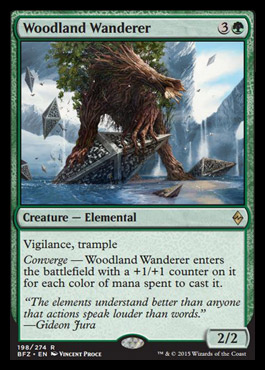
Jason Alt: Out of all of the Converge cards, this may be the best. Potentially a 6/6 for 3G, this card is quite good in Limited and has the potential to wreak some havoc in Standard. I’m not super bullish on many of the converge cards, but this could be sweet. Abzan and Temur might like a 5/5 for 4 that has vigilance and trample and while not living to its full potential may be sad, its rate is nothing to really sneeze at. This could be above bulk, but a rare in this set will have to be pretty good to break the $2 mark.
DJ Johnson: Another “this kills Siege Rhino so it won’t be bulk” Magic card. Abzan might want this to complement their own Rhinos and beat out the mirror for a week or two, but I don’t think that makes this card something to buy. I don’t think we want to push into four colors just for the bonus counter, but this probably isn’t pure bulk. Sell them out of your dollar box or dollar binder when you get the chance, maybe it hits $2.
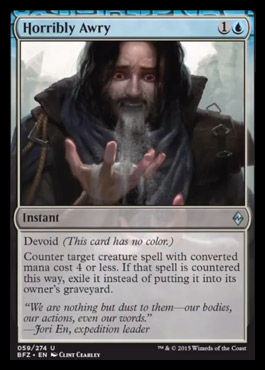
Jason Alt: Something is going horribly awry if they think a worse Essence Scatter needs to be uncommon to compensate for the fact that they can’t Red Elemental Blast it. Is exiling the card worth playing this effect in a set with huge creatures? Hard to say, but this set doesn’t give us a lot of counterspells to choose from.
DJ Johnson: Wizards really doesn’t want two-mana counterspells to be good, but that won’t stop people from playing them. I think we can still play this in Standard, because hitting Siege Rhino is just that important. I’m picking these out of bulk, and trading them out at $.50 or $1.00. Man, this art is just weird. The guy is breathing out dust.
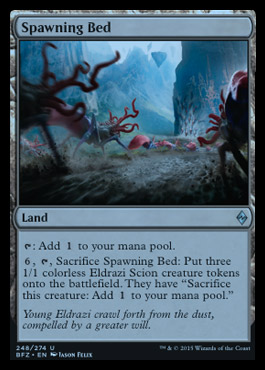
Jason Alt: Now THIS I like. I don’t think it will ever break the $2 mark under any circumstances, but foils might be cool in EDH. I really like the idea of making 6 Scions with Parallel Lives an then bringing the land back with Crucible of Worlds. I don’t expect this to get more play in Standard than Foundry of the Consuls, a card you are about to google because you don’t know what it does.
DJ Johnson: The uncommons in this set are better than most of the rares. This card is sweet, even though I don’t think the power level is high enough for my Child of Alara lands deck. This will definitely not be bulk, so pick these when you pull them. It’s not a chase uncommon like Bile Blight, but you can grind value out of these. I’d rather play this over Sanctum of Ugin any day.
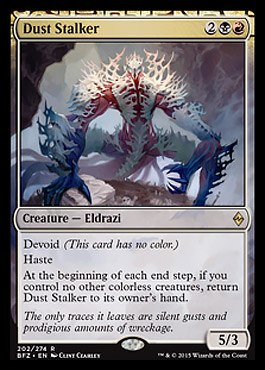
Jason Alt: Honestly, a lot of these colored-yet-devoid Eldrazi are the more interesting ones. Having a weird form of Archwing Dragon’s ability, this rewards you for having other devoid, artifact, Eldrazi and Scion creatures. Worst case scenario, you rebuy him every turn and Ball Lightning them. I don’t know if this will be good or not, and the 3 toughness is a real blow to his playability so I suspect this maxes out at a few bucks and I’m not pre-ordering any.
DJ Johnson: This guy is probably a little bit better than a bulk rare, but I still really want him to be good in an aggressive Eldrazi deck in Modern with Eye of Ugin. That deck is super bad, but just looks like a lot of fun. I don’t expect him to be more than $2, but I don’t think he hits pure bulk status either. Don’t pre-order it, wait a few weeks.
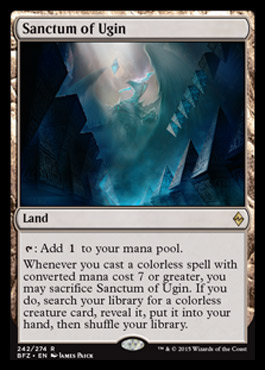
Jason Alt: Initially, I thought this would be cool in something like a Daretti deck but I realized everything I want to trigger this with and fetch costs 6 mana. What’s 7? Sphinx Bone Wand to go get a Draco? Spine of Ish Shah to go get Bosh, Iron Golem? Searching for Platinum Emperion or Platinum Angel or Blightsteel Colossus could be cool, but this seems like it’s a tough sell in a lot of decks. Skittering Invasion lets you go grab It that Betrays for flavor? There aren’t a ton of possibilities and this almost feels like a win-more. Could Standard give a crap about this card? I like this less than Ally Encampment and don’t think that card has a financial future, either. Eye of Ugin this is not.
DJ Johnson: Meh. I thought this was an uncommon when my friend read the effect to me in the car, and I really don’t want to open this in a booster pack. I’ll probably play it in Glissa EDH because casting All is Dust to find Blightsteel Colossus is a game ender, but that’s about it. They’re printing way too many “Eldrazi/colorless guys matter” lands, and you can only fit so many in a deck. Only the best ones will float to the surface, in Standard/EDH/Modern. This one won’t be one of the better ones. Bulk rare.
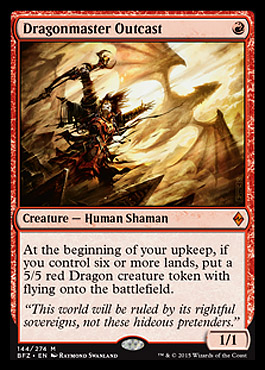
Jason Alt: Well, this WAS going to be worth more money long-term. Being reprinted at mythic isn’t as disastrous for the price as a regular rare printing but this is no reason to celebrate. Last time around this got less play than Scute Mob and this was mostly for the casuals. Will Standard be slow enough to grind value out of this guy? I’d like that. He’s certainly powerful, that’s for sure. It’s really difficult to predict a card’s viability based on past viability of analogous cards and the same holds true for reprints. This entire set looks slow enough for this card to thrive, even red decks. This could be a thing. The crashing price will eventually recover so I like this as a pickup when it craters, which may be at presale and may be at rotation, which comes sooner than it used to.
DJ Johnson: I’m kind of disappointed that this got a mythic slot. The new flavor text is kind of cool, but I really think this would’ve been fine at rare. The new printing will put a temporary stopper in its’ slow growth from the casual appeal, but it’ll creep back up. I don’t think we’ll be seeing him in Standard though, so sell any copies now while you have the chance.
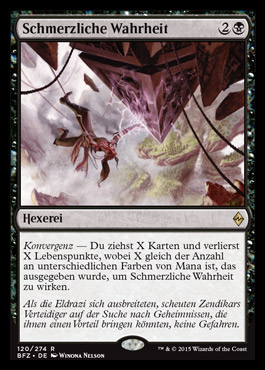
Painful Truths
2B
Sorcery
Converge – Draw X cards and lose X life, where X is the number of colors of mana spent to cast Painful Truths.
Jason Alt: The painful truth is this card is worse than Read the Bones and it’s a damn rare. A bulk one.
Spikey players are far more bullish on this card than I am. Since they will be brewing decks for the new Standard, what they say should be taken into consideration. They like that it digs deep and nets you more cards than Read the Bones in a three-color deck. I don’t know if I like it without some scry in there, but at least read what they are saying.
DJ Johnson: It’s paining me to write about this card. Converge is the dumbest “keyword” mechanic they’ve come up with in several years, and I hate every card that has it.
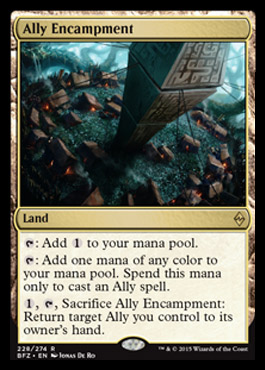
Jason Alt: Look at Sliver Hive for the maximum amount this can be, then subtract a bit because this set will sell way more than M15 did, then subtract more because Slivers are way more popular than allies. You likely get a ceiling that is below the presale price. Still, this land is amazing in allies decks. It’s too bad it’s so narrow and Slivers are infinitely better. This is great for saving an ally from death AND getting an additional trigger out of a key ally. This is very, very good and will be a 4-of if an ally deck materialzes, which will help you if you bust them early and catch a few people scrambling to put together a playset week 1.
DJ Johnson: This might actually be good enough to push allies into Modern. Bouncing an ally isn’t too big of a setback when you can just Vial it into play again for multiple tricks. Expect this to drop lower and lower as more packs are opened, but I don’t think this is unplayable in the Modern ally deck. Standard is a whole different story, and I still don’t see enough cheap support to convince me that the deck will be a real thing. Trade these off to anyone trying to build the deck during release weekend.
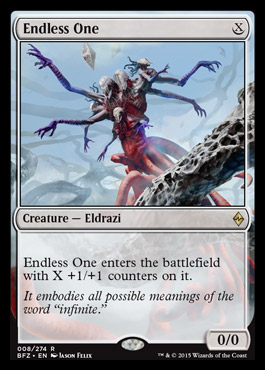
Jason Alt: I literally have no idea how to assess this card. I’m glad this exists for Limited. Will this be worth any money? I don’t see how. This goes back to LSV asking how good a vanilla 15/15 for 5 mana would be. Would it be game-breaking because it’s a one-hit KO or would it getting chumped all day make it not that great? I feel that way about this card. You’re paying Eldrazi mana for Eldrazi power but nothing else. Lands and stuff that make Eldrazi cost less mana to cast make this better but printing this right after Hangarback Walker makes it look even more “meh”. I think this is a bulk rare that you p1p1 in a draft just because you can always summon it, and it’s likely a 6/6 when you do, making it slightly better than Phyrexian Hulk.
DJ Johnson: This card is sweeeeet. I really want to build a Modern deck (did I just say that out loud?) where you play Eye of Ugin as a 3-4 of, and jam multiple copies of these out on turn 1 as Eldrazi Bears. We can add Urborg to let Eye tap for mana, and black gives us access to Dominator Drone, Forerunner, Dust Stalker…. I really want this to be a deck. Even if it’s worse than Tier 2, this will be a 4x. However, it’s still going to be a bulk rare soon after packs hit the shelves.
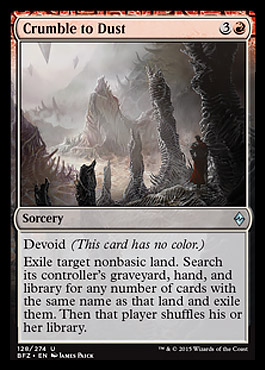
Jason Alt: Sowing Salt, instead of getting a third printing, got easier to cast and harder to Flashfreeze. People are excited about this, and having it in Standard could be good. I like this card a lot. This was Manadeprived.com’s preview card, which no one really knows because someone spoils their ultra-coveted preview card and literally 10 seconds later it’s on MythicSpoiler, the only place people check, and people forget who spoiled it. If it sounds like I’m just rationalizing the fact that Brainstorm Brewery has never gotten a preview card, you’re absolutely right. This is an uncommon that will be worth more than half of the rares in the set. Grab these from draft chaff if they’re lying around and try to buy these for a quarter if you can. This is a real card.
DJ Johnson: Probably the chase-iest uncommon in the set, and with good reason. This is a very powerful effect, and will almost certainly replace Sowing Salts worldwide. This will be a $1-2 uncommon, and you should never let these go for less than that.
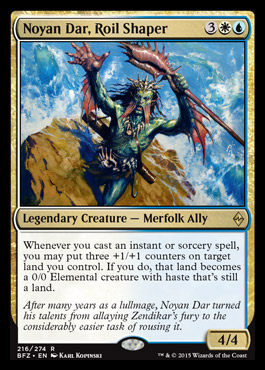
Jason Alt: This has… nothing to do with Allies. Or Merfolk. I’m so confused! This guy had to have a tribal affiliation so they gave him one, but this is just a sweet EDH commander. You jam Talrand and creatures with Prowess in the same deck and go to cantrip town. Buyback a Capsize? Swing with your new 3/3 land and 2/2 drake. Double a copy of Preordain with Mirari? Value town! This deck could play other UW merfolk favorites like Sygg, River Guide to keep your commander alive. This doesn’t necessarily not synergize with other merfolk and other allies, I guess, but this seems like a great standalone card I’m excited to design an EDH deck around. Oh, also, bulk rare.
DJ Johnson: Bulk rare, and a really weird one at that. This isn’t my cup of tea, so I’ll let people like Jason go crazy about figuring out their EDH shenanigans. Meanwhile, I’ll be over here tinkering with BR Devoid Aggro in Modern….
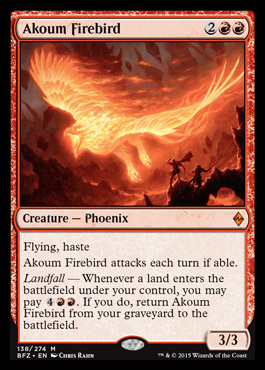
Jason Alt: People always wanted Phoenix cards to be good and too often they’re overshadowed by dragons. I fear this may be the case here. a 3/3 just can’t body a dragon the way you need it to. Coming down on turn 3 or 4, this can do some real damage before it’s overshadowed by bigger creatures that it can’t swing through. While this turns late land drops into threats, letting you make each land drop turn into a chance to add 3 damage to the attack, this ties up a lot of mana, too. This is one of the better Phoenixes we have seen, but we’re all used to seeing promising Phoenix mythics do nothing. I don’t see enough here to convice me that this will be any different.
DJ Johnson: Noooope. I’m not the local mono-red expert, but I really don’t want to cast this while Thunderbreak is hanging around. Hell, even Avaricious Dragon seems more enticing late-game to dig for your gas. Being forced to attack every turn really sucks, and these guys aren’t even great in multiples. You’re not going to be bringing back multiples of these like you could with Bloodghast. I’m calling $2-3 short-term, I’ve been burned on too many phoenixes before.
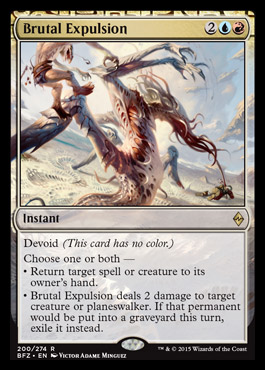
Jason Alt: This seems amazing to me. This is the card they wanted Suffocating Blast to be but it’s so much better. It doesn’t have the fatal design flaws of Suffocating Blast, it’s more castable and it can’t even be countered with Red or Blue Elemental Blast which won’t be relevant but which is non-trivial. This is pre-selling for $3 and I don’t know if I hate it at that price. It will take a lot of standard adoption but Jeskai and Temur decks can both play it. Will they want to? Is it worth 1R to add a Magma Spray to a Venser? I feel like this could see play, but going above $3 will be tough with so many reasons to buy boosters. I’m not feeling great about this as a presale buy, but I like the card.
DJ Johnson: Jilt got a little bit of an upgrade over the past decade or so. While I don’t think this will see play beyond Standard, it does seem like a solid card. If you desperately need them for some sort of Jeskai deck during opening weekend, then I wouldn’t call you an idiot for pre-ordering them at $3. However, I would call you an idiot for buying out SCG at $3 and then hoping they miraculously hit anything higher than that. It will probably drop to $1-2 over time, and sit there for a while.
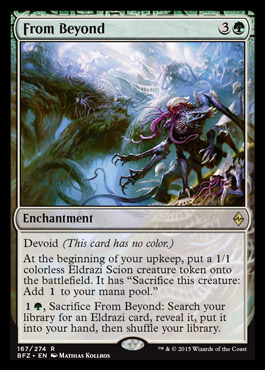
Jason Alt: What? The made Awakening Zone into a tutor for Eldrazi that sits out there and gives you “if you control another colorless permanent” triggers for days? This doesn’t force them to attack like Goblin Assault, doesn’t make 0/1 creatures like Awakening Zone and only has 1 colored mana symbol. This card is stupid. Awakening Zone gets a lot of EDH play and this is better in every way. I don’t know if it will see enough Standard play to make the price go up before it goes down but this card is dumb and I wouldn’t be surprised if some Eldrazi ramp deck emerged with this as a 4-of. At $3 Buy it now, I don’t know if you don’t just order your playset now.
DJ Johnson: This card is sweeeet. I really wish 90% of the stuff in this set wasn’t colorless, because I miss out on all of the synergies with my Savra deck. Regardless, this card just oozes value. The tokens are beefier, the card tutors to your hand late-game when you don’t need the 1/1s anymore, and the art is just insane. I think a $3 price tag is perfectly reasonable, although this does fight for a slot with Frontier Siege in the Eldrazi Ramp deck. I’m not sure which one you want, but this has a lot of legs in EDH as well. I’d sooner buy these at $3 before Brutal Explosion.
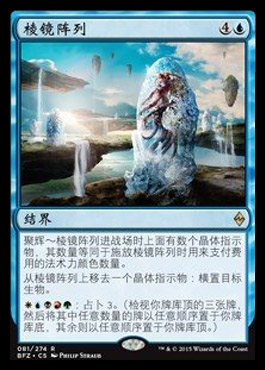
Prism Network
4U
Enchantment
Converge – Prism Network enters the battlefield with hedron counters equal to the number of colors spent to cast Prism Network.
Remove a hedron counter from Prism Network: Tap target creature.
WUBRG: Scry 3.
Jason Alt: I don’t know who wants this card. Maybe the guy playing the 5-color Maelstrom Nexus deck? That scry 3 will set you up for some sicko Cascades, I guess. Everyone else won’t bother. Bulk.
DJ Johnson: I’m not going to waste words on this card.
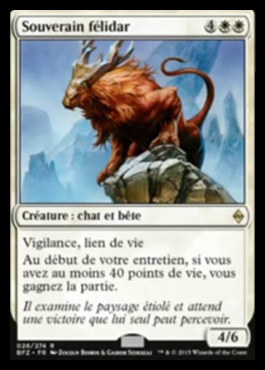
Jason Alt: Ugh. This card won’t even really be that good necessarily. Basically all this did was cut the legs out from under another solid EDH card that was easy to trade for because competitive players didn’t care about it and which EDH players overvalued in trades. This going from Mythic to rare will likely make this total junk and I don’t see it exceeding $5 ever again unless this ends up a 2-of in Standard decks. I’m disappoint.
DJ Johnson: Remember how Sanguine Bond used to be like $10, until a one-two combo punch took it to the dollar bin? That’s what’s going to happen with this oversized goat. EDH and casual players were the only ones driving that Jackson price tag, and now this thing’s price is literally going to be decimated. On the bright side, I’ll sell more $1 Sovereigns than I ever did $10 Sovereigns.
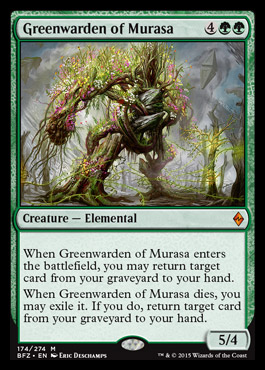
Jason Alt: As an EDH player, obviously I’m super excited here. This is a real skill-tester, forcing you to decide between removing him from the game to get greedy or leaving him in the yard to be able to recur him for value. This is a non-relevant body in EDH which makes him appeal a bit more than Eternal Witness and the ability to get a card, sac him to Greater Good or something and get another one and other shenanigans makes him really appeal. Could this see play in Standard? Yes, I think so. EDH will prop him a bit long-term so buying at the presale price of around $7 doesn’t seem ridiculous to me. This will never be a bulk mythic and any modicum of Standard play pushes him over the edge into “duh” territory. I’m happy with this card, though my EDH blinders tend to cause me to say things like “I love Hangarback Walker! This is great in Vorel, so buy a ton of these when they’re bulk” so take my assessment of its Standard playability with a grain of salt and buy in (or don’t) accordingly. $7 is good if Standard plays this and it’s bad if it doesn’t.
DJ Johnson: This card is sweeeeeeeeet. Eternal Witness is in my top 5 favorite cards of all time, and I’m glad Wotc has given the “OK” to ETB effects being able to bring back any particular card in the graveyard instead of sticking with sorceries like Treasured Find. This was pre-selling for $5 on 9/10/15, and I was very tempted to pull the trigger, just because I think this is one of the exact cards we want to find with See the Unwritten. It brings back See the Unwritten with its’ ETB trigger, then gives you Ferocious next turn for the double search. I think pre-ordering these at $7 is fine if you need them to play with, but I would hold off on the speculation train. Still, this card is ridiculous in EDH, and some decks will swap out Ewitness for it.
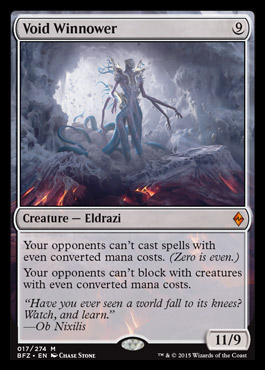
Jason Alt: Now your opponents literally can’t even. That one was an obvious joke, but the next thing I said about the card was literally almost “this is a really odd card” which was not deliberate. It is, though, isn’t it? Very odd. And it’s hard to know where this wants to fit in. EDH can obviously use silly stuff like this. I think this effect is great in Modern where your opponent can’t cast Tarmogoyf or Splinter Twin and can’t block with Ornithopter. Do we want to play this in Tron, though? All the Eldrazi are getting a look, but this one doesn’t have an obvious home anywhere. It’s a cool card and can certainly frustrate opponents who are normally even-keeled (last one, I promise) but do we want to pay $6 for this? I don’t. Think of what it would take to make this the $15 or so you’d need to really make money speculating at $6. I don’t think this is that card. It sure is fun, though.
DJ Johnson: If you ever make a bad “odd” or “even” pun while talking about this card, our conversation will end and I will walk away. The part where it says “Zero is Even” will be relevant in situations where most tokens and creature lands try to block, because their converted mana costs will be zero. However, do you want to play this over Ulamog in Standard? What do you take out for it in Modern? It’s definitely worth noting that it cancels out the See the Unwritten mirror by preventing them from slamming their six-drop sorcery…. But at at $6 pre-order, I’m shaking my head. You can wait for this to be a $3 mythic.
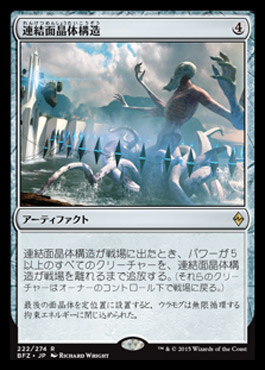
“Hedron Network”
4
Artifact
When Hedron Network enters the battlefield, exile all creatures with power 5 or greater as long as Hedron Network remains on the battlefield.
Jason Alt: This is preselling for the same price as some mythic rares in this set. Some people seem really bullish on a slow, temporary Wrath of God. Is it a slow Wrath or a selective Oblivion Ring for their side? In Standard, small creatures are currently killing people. What does this get rid of in Standard? Where do we want this? I’m not comfortable paying $5 for this until people demonstrate that we’re going to get a lot of big Eldrazi with this because I think you just wrath them, otherwise. This lets you play with small dudes and dodge the removal, but I think if they have mostly big ones and you have mostly small ones, you want to win by racing them or playing targeted removal for a big creature, not this. I like the card a bit, but don’t see a deck for it. Is that just me?
DJ Johnson: I’m not a fan of this card, especially at anything over a dollar or two. You have to be getting 2-3 guys with it while dodging all of your own creatures for it to be worth playing over a single targeted removal spell, and I don’t think the weenie deck wants to spend its’ turn dropping a 5 mana artifact. I’m confident that this will be a bulk rare soon after the sets’ release, and I highly suggest fireselling all of your copies ASAP.
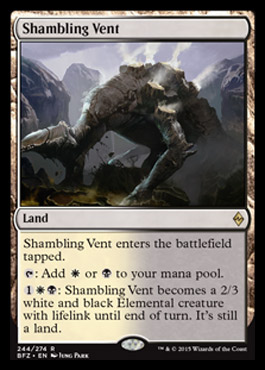
Jason Alt: I guess everyone pretty much expected this to have lifelink (some wanted deathtouch) and I can see this slowly grinding the game back into your favor. Wiping the board and then serving for a 4-point life total swing in your favor seems solid to me. I imagine “solid” will be the way we describe this card. Is there a deck for this? This is the only manland Esper decks get in this set, so maybe it will have to do. There are $5 Buy it Now auctions for this card and I don’t hate that, but I feel like our expectation for the price of a narrow land is predicated on sets that won’t sell as well as this one. This needs to be better than we think to go up from its presale price? Is it better than I think it is? I don’t think so, but only because no other outcome is possible. I think it’s as good as I think it is. At least I think I do. I don’t hate this as $5, but I feel like it’s got a poor risk:reward ratio at that price.
DJ Johnson: I really don’t like this. I mean everyone knew it would have lifelink, I just didn’t expect the power and toughness ratio to be so weak. I feel like this is going to be another Lavaclaw Reaches, and because of that I really don’t like the pre-order price of $5. Maybe because it’s the only Esper-colored one this time around, that will be its’ saving grace, but Esper already has really good mana without this. I don’t want to pre-order this, I’d wait until it hits $2 to pick them up in cash.
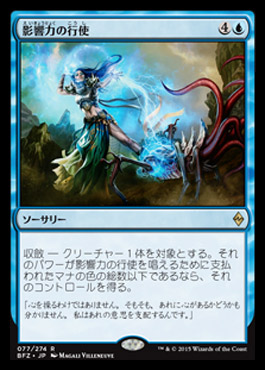
Exert Influence
4U
Sorcery
Converge – Gain control of target creature if its power is less than or equal to the number colors spent to cast Exert Influence.
“I cannot control its mind, I’m not even certain it has one, but I can dominate its will.”
Jason Alt: I hate this card. This card is so bad. Why is it so bad? I had to read the card a second time to make sure it was as bad as I thought it was and then I realized it’s actually worse than I originally thought. Do you like Mind Control effects that only work on certain creatures? Well how’d you like to pay 5 mana for it? Lots of Eldrazi in this set, but don’t worry, you’ll never take control of one of those with this RARE. Ugh. This is a bulk rare and I hate that they couldn’t figure out a better way to make this stupid card. Why not a card that cloned a creature with power less than 4 and made a copy for each color you used? That would be weak but it would be better than this trash. Thanks, WotC.
DJ Johnson: I feel insulted. I would rather have actual Mind Control as my rare.
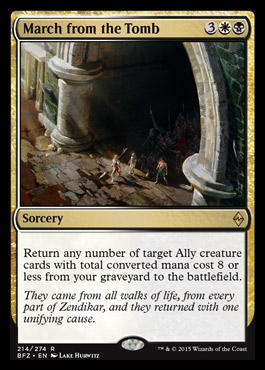
Jason Alt: This card is very, very good. What I don’t know is whether this card will be expensive. I have to imagine it all hinges on whether an allies deck materializes and I think that hinges on the commons and uncommons in the set. This could be a poor man’s Rally the Ancestors of sorts, also, allowing you to play a dredge-style deck and flooding the board with allies. One thing it took me a second to realize is that if you have a lot of small allies with decent abilities, you’ll get hella triggers out of this. However, the powerful allies we’ve seen are all like 5 mana. Getting one and a half creatures for 5 mana is a bummer. I am inclined to call this bulk, and I think that’s safe to say for now. It really hinges on what we can get for 5 mana and a card and I’m not impressed yet, but I reserve the right to change my mind when I see the full spoiler. This seems very, very likely to be cheaper in a month than it is now, though.
DJ Johnson: And we have another 5 mana ally card. Seriously, they are printing so many allies that cost 3 or more mana, so it’s all the more reason to stay away. The most value you’ll get out of this is if you bring back a bunch of Hada Freeblades and other assorted two drops that don’t exist yet. I really think this will be another Immortal Servitude, not another Rally the Ancestors. Stay away, it’ll be a bulk rare in a month if you want one for EDH purposes.
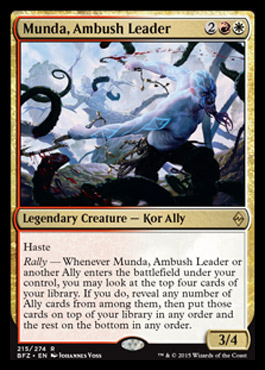
Jason Alt: Well, this is solid. This makes me wish there were enough allies to play allies tribal in EDH since this as your commander, especially with a sac outlet could stack your deck with value over and over when cast from the Command Zone. As it is, I don’t like this a ton in Standard although this is probably a 3-of in the allies deck if one materializes so this can’t be truly bulk if the tribe is at all appealing. This doesn’t trigger anything with the Kor so his second tribal affiliation doesn’t matter, which is too bad. All in all, this won’t be bulk but I don’t see a way to make money on this card unless it presells for literally a dime a copy. I don’t think it will so I don’t think I will. Buy any, that is.
DJ Johnson: Did they put Ryze from League of Legends into card form? I feel like this was originally a Goblin Ringleader for allies, but that got dumb real quick, and they decided to nerf it down to just stacking your deck with more allies. I still haven’t seen allies that would suggest the tribe be anything relevant as an aggressive deck in Standard: They have yet to even preview a 1 or 2 drop for the deck; all of the ones they’ve spoiled so far cost 3 or more mana. Until I see some aggressive opening possibilities that would make the tribe relevant in Standard, I’m staying far away from Allies, at least the ones in BFZ. If you want to spec on Allies, go deep on Hada Freeblade.
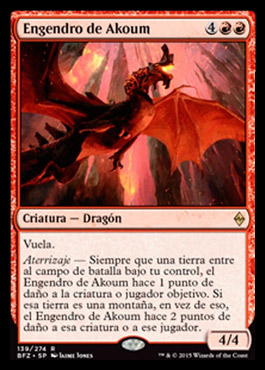
Spawn of Akoum
4RR
Creature – Dragon
Flying
Landfall – Spawn of Akoum deals 1 damage to target creature or player. If that land was a mountain, Spawn of Akoum deals 2 damage instead.
4/4
Jason Alt: This is some “flavored” landfall I can get on board with. Shocking them for landfall triggers in a mono red deck gives your dragon considerable reach even if it can’t attack, and something like Nissa’s Renewal becomes a shotgun blast. Is this the card we want in the dragon slot? We’re losing our favorite dragon in red but keeping Sarkhan. Is how good this landfall is going to unseat Sarkhan? Will this go in a different deck? 6 mana is a lot to pay for a 4/4 but if we can shock people at will, I could see this getting up to $3-$5 if Standard cares about it.
DJ Johnson: Another Bulk Rare dragon, another day. It wouldn’t be a set without a good old bulk rare dragon. I’m pretty sure it’s actually mandatory to stick a really bad dragon in every set at this point. Buuuuulk raaare.
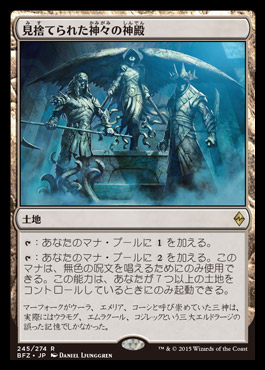
Temple of the Forsaken Gods
Land
T: Add 1 to your mana pool.
T: Add 2 to your mana pool. Use this mana only to cast colorless spells. Activate this ability only if you control seven or more land.
Jason Alt: If this could cast any kind of spells, this could replace Temple of the False God in EDH decks, but since it can only cast colorless spells, I don’t see that happening outside a handful of decks. Daretti, maybe? I hate the restriction here and don’t think it would have killed them to just make a land that taps for 2 colorless if it’s your SEVENTH land. Especially at rare. They could have had an EDH staple and instead they created a forgettable land that meshes OK with the rest of this set and doesn’t do much else.
DJ Johnson: This just feels like they tried to make something that was both worse than Eldrazi Temple and worse than Temple of the False Gods. I don’t want it in Standard, and it’s restricted to only a handful of EDH decks. It goes in my Glissa deck because that’s almost entirely colorless, but I really don’t think this will be more than a dollar after a few weeks of pack cracking. Stay away.
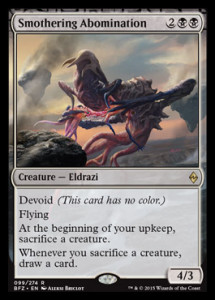
DJ Johnson: I think it’s funny that the first card I’m excited to jam into an EDH deck in Battle for Zendikar isn’t going to be going into my 5 color Lands deck. Smothering Abomination looks like it’s going to fit right at home in Savra, the deck I’ve been working on foiling out for the past 4 or so years. Can you all do me a favor and not play this thing anywhere, so it becomes a bulk rares? I would prefer to pay basically nothing for the one foil copy I need. I actually don’t think this card is outside the realm of Standard playability, but it needs a very specific list to support its synergies. You need to be able to make a bunch of Eldrazi scions, or some other tokens at a good rate before he eats himself. It’s worth noting that this says non-token, and that you can choose to make him eat himself if you’re done feeding him.
Jason Alt: Eww.
OK, since a lot of people want me to clarify, this card is fine and I’m likely jamming it in Prossh. However, I first checked the price and saw this at $7. No thanks. Its subsequent plummet to roughly $3 is slightly better but still, honestly, EDH alone won’t buoy this enough to make em want to buy in. I like him as a one-sided Fecundity in EDH but he’s too much of a liability for Standard and that will set his price.
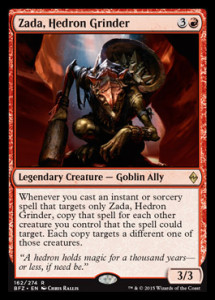
DJ Johnson: This is a bulk rare for any number of reasons. Bad power to toughness ratio, weird ability that requires jumping through hoops, etc. I mean, I guess it’s an ally, but do you really want to be jamming a bunch of Heroic-like instant and sorceries into your tribal Ally deck? I didn’t think so. NEXT!
Jason Alt: Douglas Johnson is WRONG. Don’t you understand what they did? Don’t you know what this means?! DON’T YOU?! Let me break this down for you people. Wizards of the Coast in 2006 saw their way clear to printing a card called Ink Treader Nephilim. Since EDH became a format, players have been clamoring for WotC to errata the nepihilim, specifically Ink Treader, to make them usable as Commanders. Some play groups just allow it. There are 5 of them, they have cool abilities and they would be the first and only 4 color Commanders. While they didn’t issue the errata people wanted, they DID give us something like its ability on a Legendary creature. And you have the gall to call this a bulk rare?! I mean, it probably will be. Still, though. Imagine casting a bunch of copies of Chandra’s Ignition until your opponent dies. This is fun on a stick and you’re complaining that ally decks suck. Hashtag shaking my head.
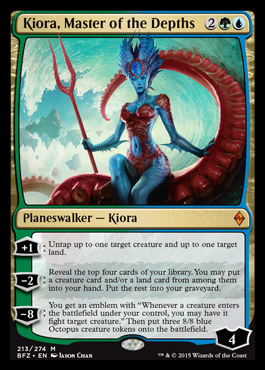
Jason Alt: This seems very good. This is the best Kiora we’ve seen, certainly. This set has good 4-mana walkers so far! I think having two abilities with and or and/or in them bodes well for its usefulness. Still, simic is a color combination WotC frequently forgets to make competitive. Is Sultai going to be good, still? Will it take too long to get that emblem, as game-winning as it can be? Will it be good in a deck with enough big creatures to make the emblem worth it? Untapping a land and a mana dork with her +1 seems good enough to make her playable, and her -2 potentially drawing two cards and even fueling graveyard shenanigans make me think this is a solid $30+ card at presale (apparently these are like $15 on eBay. People are really bearish about singles in this set and with so many reasons to bust packs, it’s hard to blame them) and while it will most likely go down, I could see this catching on.
DJ Johnson: Finally, a card that I’m not pessimistic about. This looks to be powerful and worth casting at four mana. While I don’t think it has guaranteed legs (or fins, I guess) in Standard, that’s mostly because I can’t think of a deck that would want it. You have to play a decent chunk of creatures to get the maximum value out of each one of her abilities, so I guess we’re looking at some sort of Bant, Temur, or Sultai midrange. I’m not going to suggest investing in her though, wait until that good old ‘Walker hype drops.
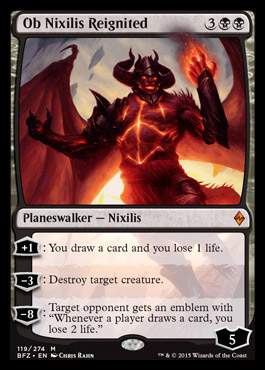
Jason Alt: This seems like it will be another $30-$40 pre-sale walker that will come down a bit. Being monocolored makes it easier to play in more decks than a walker like Kiora, but I think this is overall less playable on a power level basis. The emblem seems better in EDH than standard although it’s pretty scary to have that emblem on you, especially if they throw another Ob out and start drawing a ton of cards every turn. He does an OK job of protecting himself from a single creature and he does a lot of things you want cards to do in a black deck. I think he’s cool but it’s hard to see him maintain $30 or above.
DJ Johnson: Is it just me, or is this the least amount of text we’ve ever seen on a Planeswalker? The abilities are so straightforward, and it leaves a lot of empty space on the card. I have no idea if that’s a good thing or not, it just sort of stood out to me when I saw him. I really don’t think he can maintain the planeswalker hype, and he’ll never see more than a 2-of in a Standard deck if he even fits into one. I’m confident that he’ll slowly drop down to $10-15, and you’ll be able to pick these up for a cheaper and cheaper as the set continues to be open. Don’t pre-order it. Please.
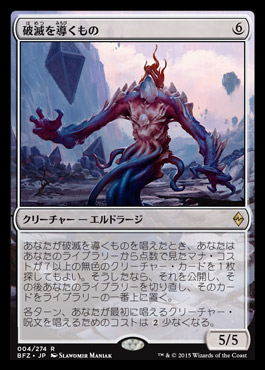
Conduit of Ruin
6
Creature – Eldrazi
When you cast Conduit of Ruin, you may search your library for a colorless creature card with converted mana cost 7 or higher. If you do, shuffle your library, then put that card on top.
The first creature spell you cast each turn costs 2 less.
5/5
Jason Alt: I got excited by the fact that this tutors for Spine of Ish Sah and other goodies until I remembered that just because you can get artifacts with this doesn’t mean you jam this in an artifact deck. There sure seem to be a lot of unplayable creatures, which either means some cards we think are unplayable now are actually very playable, or the value of the set will be in lands, planeswalkers and spells. I think it’s probably a little of both.
DJ Johnson: 6 mana 5/5s? Is that what the Zendikarians are up against? This war is going to be no problem is the big old Conduit of Ruin gets knocked out by a Sun Titan in Commander. Tutoring to the top of your deck sucks anyway, I’d rather just play Fierce Empath in EDH and abuse the ETB trigger over and over again. Bulk rare.
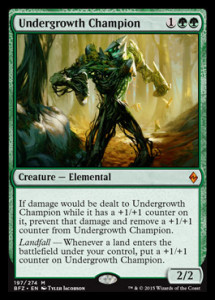
DJ Johnson: I’m not impressed. You seriously have to keep pumping out lands every turn to make your Grey Ogre not die to Lightning Strike? I get that you have fetchlands and other landfall synergies, but I would at least expect a solid starting P/T ratio, or maybe trample. This is not a mythic that I want to be opening up, and there are a good chunk of uncommons that I would probably pick over this guy in Limited. I highly doubt this has legs in Standard, or any real format. It’s not even bomb-worthy of a 99-card list. Ship them if you crack them, and don’t look back.
Jason Alt: This would really be oppressive in combat in a universe where they never printed Terror variants.
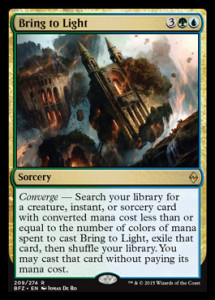
Jason Alt: This is really good in a really small number of situations. EDH players are excited, but unless you have a 3 or 5 color commander, you’re tutoring for stuff you aren’t necessarily jazzed about. I’m not paying 5 mana to tutor for a Coiling Oracle in a Vorel deck, but in a 5-color deck this is good. Even tutoring for a K-Grip in a Sidisi deck could be worth it. This is one of the better tutors we’ve seen in terms of impact although how slow it is could keep it from materializing as a card. Still, it’s versatile and maybe it’s worth getting excited about.
DJ Johnson: So everyone on my Facebook feed is losing their goddamn mind over this card, and I can’t see why. You have to vomit up rainbows to tutor up anything remotely high-impact, and you still have to pay to cast the card later. I guess they can’t rip you off with Thoughtseize immediately after you search for what you want? Woohoo……. I’m pretty sure the only reason this card is rare is because it has a lot of words on it, because Diabolic Tutor is an uncommon, and I’d sooner play that in Standard. Buuuulk rare.
EDIT: Thank you for everyone on Twitter for letting me know I’m an idiot, and that I misread the card. You do in fact get to cast the card immediately, but I’m still not sold. You have to jump through so many hoops to there, but I don’t think it’s awful in EDH anymore. For what it’s worth, I don’t think i’ll be putting this in my 5-color Child of Alara EDH. I just love Wargate too much.
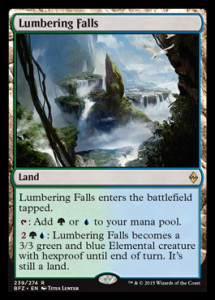
DJ Johnson: It’s no Celestial Colonnade, but it’s no Lavaclaw Reaches either. Tar Pit and Colonnade see Modern play because of their evasiveness and ability to end games that go long without taking up spell slots, but I don’t see this one seeing play past Standard. I really don’t think we’ll see these go past $6-7 in the medium-long term, unless one of them proves to be far and beyond better than the rest. Depending on how the other four turn out, some of these will likely be near-bulk rares like Lavaclaw and Stirring Wildwoods. Unless you’re 100% positive that you need a playset during release weekend, I don’t think you need to buy in at this moment.
Jason Alt: Wow. Hexproof. Way to think outside the Keyrune. The good manlands have a good ability like flying or unblockability. The bad ones durdle. This durdles harder than I have ever seen a manland durdle.
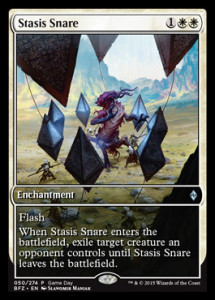
DJ Johnson: A fixed Journey to Nowhere with flash. It’s crazy how Wotc can continue to come out with new card after new card just by tweaking small aspects of previous iterations. We’ve come a long way from Oblivion Ring, and I think this has the power level to see Standard play. While this art is taken from the Game Day promo, you’ll be able to pull the non-promos from draft chaff and keep them in your binders to trade out for $.50 to $2.00, depending on the Standard environment. Think Bile Blight and Banishing Light, and pick up these accordingly. It’s not something you want to drop $20 on and buy out TCGplayer, but they won’t be irrelevant bulk.
Jason Alt: I like how this plays. I don’t like the play of targeting these promos unless you trade for them. This is a good card but I’m not sure it will be relevant outside of Standard, so I’m not excited terrible by the promo even though it looks as cool as the Expedition lands should look.
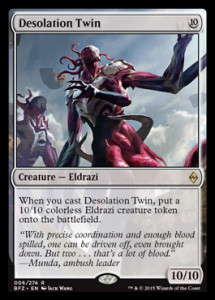
DJ Johnson: Timmy, meet Desolation Twin. Timmy, meet Desolation Twin’s, well, twin. For 10 colorless mana, we get two 10/10s. Half of this guy is uncounterable, but I still think we’d rather have Ulamog if we’re talking about a competitive Standard environment. This definitely isn’t worth casting See the Unwritten, but I still don’t think it’ll go to pure bulk rare status thanks to our good friend Timmy. I’m thinking this will be a dollar rare throughout its’ lifetime, and you should sell them to non-competitive players while being satisfied about that price range.
Jason Alt: I’ve seen worse cards end up a few bucks thanks to casuals. If these hit bulk, take these to your local community college and watch people let you go deep on their binder. This is an exciting card for people who still get excited about cards and it’s worth knowing this will appeal to the kind of players who aren’t terribly excited about a land that taps for two colors of mana. I am trading for these at $1 because this is great trade bait for the only group of people I still want to trade with.
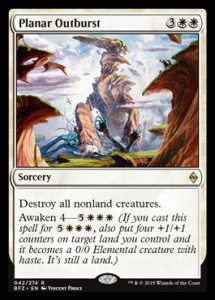
Jason Alt: They keep giving us 5 mana wraths and trying to make the text boxes worth it for us. I think this is likely pretty close to playable, but do we want this over End Hostilities? Will this ever be worth more money than that card? I would check that for similar price trajectory because this card has even more downside if this set ends up being more popular than was Khans of Tarkir. This is an acceptable Wrath as far as 5 mana Wraths go, but being a turn too late won’t make you feel any better if you get to keep an animated land. Playing this for 8 mana wins games in Limited but could also be a play in Standard. All in all I’m never excited for 5 mana Wraths, especially since we haven’t seen one go above its pre-sale price in a long time. EDH would rather play Phyrexian Rebirth or Martial Coup.
DJ Johnson: I’m going to have to parrot Jason here, as the parallel between this and End Hostilities is pretty clear. While this does have a nice late game tag-along effect, how often are we going to want more than 2 of this in a list? While I can definitely see it getting played in Standard, I really don’t think we can see this go up beyond $1, maybe $2. This isn’t even close to Supreme Verdict power level, and the price will reflect that.
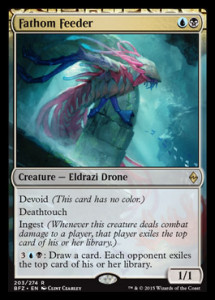
DJ Johnson: Alright, so this appears to be a weird hybrid of Azure Mage and Baleful Strix. While Strix sees a decent amount of Legacy play due to the fact that he freely trades with anything Griselbrand sized and replaces himself with a card automatically, this requires a significant amount of mana to invest for each card drawn, and the exile is (so far) pretty negligible, because the only think we can do to synergize with it is make Scion tokens or steal lands. Maybe this sees play in Standard in UBx control as the Azure Mage slot after they board out all of their removal, since it can trade with their Anafenzas and Siege Rhinos, but I’m not sure how many copies you want. A card really has to shine to be worth more than a couple of dollars in this set, but I don’t think this guy is worth calling a bulk rare, at least not yet.
Jason Alt: This is a good effect with a very fragile body and a very expensive activation. I don’t really know the whole set, but I’m having a lot of difficulty envisioning a Standard format where I want to pay 5 mana to “ingest” a card to access later with other Eldrazi, or put in their yard with a processor. The difference between this and a card with a better rate that affects the board a bit more is likely the difference between Tasigur and Shaman of the Great Hunt. I think this skews a bit toward Shaman so I’m skewing toward “not really interested in ordering this.” This entire cycle seems too mana-intensive but I could be evaluating that in terms of how fast Khans block is. If we get a slow block after this one, maybe these durdle monsters have upside, but I can’t really see playing this even as good as a Treasure Trove on wheels can seem on paper.
As a counterpoint, Ryan Bushard and Corbin Hosler went into the tank on this card for a while and emerged pretty bullish on it. Drawn early it trades with their best dude. Drawn late, you draw cards. At $1.49 on SCG preorder, it’s the lowest risk there is.
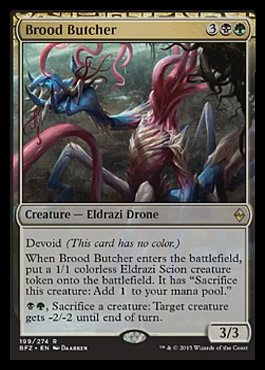
Jason Alt: It’s hard to know what Standard will look like. This card could very easily impact the metagame. It gives you a creature you can attack with, ramp with or use to half-assed-last-gasp and that’s pretty sweet. Is this effect good enough to pay 5 mana for 4 power? I see a lot of these are really good in Limited but it’s hard to imagine beating Khans block cards with weak shenanigans like this that are creature and mana-intensive.
DJ Johnson: I love the black and green color combination. I’m a Golgari as Jason is a Simic. Even with that strong bias, I really can’t see this breaking out in Standard. You’re paying 5 mana for only 4 power and toughness split across two bodies, and the activated ability is going to be really hard to pull off in succession with the strict mana requirements. You’re probably tired of me stamping “BULK RARE” on 90% of the cards in the set…. but…. bulk rare.
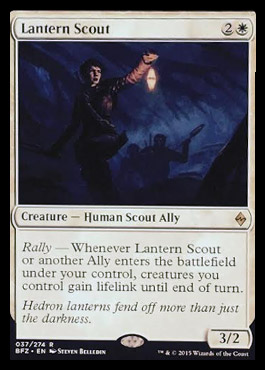
Jason Alt: Rally is just another keyword ability the set really didn’t need. Still, this card is nuts, actually. Giving allies all lifelink is beyond a beating and this is going to put games out of reach in Limited. This is obviously like a 2-of max in Constructed so I’m not super bullish on the price. Think of how many boxes of this set are going to sell. You need to be Hangarback Walker good to be above a few bucks. I’m not preordering this guy but he is pretty good, and has a decent rate to boot. P1P1 in draft if you’re a nut like me.
DJ Johnson: At least this ally has a semi-decent P/T rate instead of Hero of Goma Fada. Lifelink will swing every aggressive mirror out of reach, but I haven’t seen any other allies that are competitively costed enough to see Standard play, let alone Modern. If you want to wait a month and find these for under a dollar, I don’t think you’ll have too much difficulty executing that plan. The effect doesn’t even stack with multiple copies of itself, which is a serious downer. Bulk. Rare.
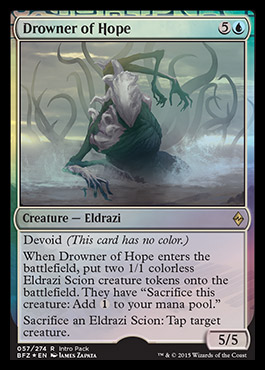
Jason Alt: This is likely a bulk rare although it’s going to be an absolute beating in Limited. Let me just say that the difference between a 0/1 Eldrazi Spawn and a 1/1 Eldrazi Scion is huge and the choice to sac what could be the lethal point of combat damage is more of a skill-tester than people think.
DJ Johnson: Enjoy windmill slamming this P1P1 in a draft, and then having trouble figuring out the 80 different lines of play it provides. Do you keep the Scions to ramp towards your 9 drop? Do you go wide and try to swing with them to get some extra damage in? Should you sacrifice them to tap your opponents’ blocker and start a race? Either way, you’re first picking a bulk rare. At least the non-promo art is gorgeous.
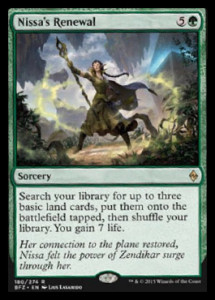
Jason Alt: This is most likely fine in EDH although it’s a weak Boundless Realms so I don’t know why you’d play both unless you were all-in on Landfall. I think this is really slow for Standard although you’re at 10 mana if you hit a land drop next turn and then you’re in bidness. Is this the kind of ramp spell any format wants? Why is this rare? So many questions. What’s clear is that landfall is going to figure heavily into this set and this gets all kinds of triggers. That said, sometimes powerful cards are still bulk rares. A lot of the time. Like this time.
DJ Johnson: I always thought Boundless Realms was extremely overpowered and needed a fixed version. For one less mana, we can get less than half the lands that Realms does, and in return we get seven life. This seems like it should be an uncommon, or at least instant speed. I don’t think I need to tell you that this is a bulk rare.
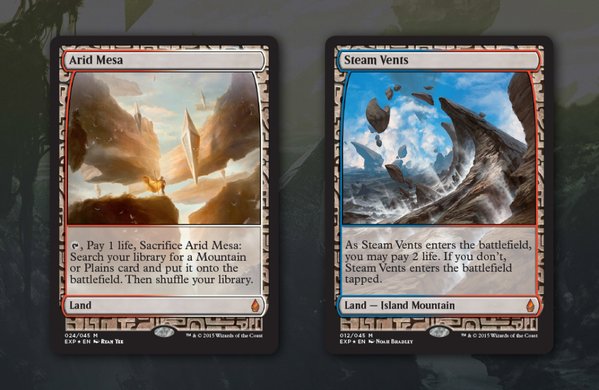
DJ Johnson: Well, these are going to be expensive. No, these are not designed to be an affordable reprint to the Zendikar fetchlands, as they only exist in full-art foil. Mark Rosewater said that you have a slightly better chance of pulling one than a foil mythic rare, so that should give you an idea of how many cases you’ll have to crack to obtain a playset of all 20 of these. I think these will easily hit $150-200, as hardcore Eternal players drop their disposable income on making their decks look as expensive as possible. This is the fetchland/shockland version of Judge Force of Will, so treat it as such.
Jason Alt: They are calling these “Zendikar Expeditions” and these will be so expensive I am talking myself out of owning them. Full-art, foil, randomly inserted the way the “treasure” cards were in the first Zendikar, rarity likely makes these $100-$150. Or more? It’s hard to know with unprecedented cards and an inaccurate picture of how many per case we can expect. Are these just the first print run? Putting a set of any of these together will be insane. This isn’t exactly the reprint to make Modern accessible people wanted, but you’d be a fool to complain about this gift. This is a $100 bill no matter how it’s folded and maybe it’s more. Go order some cases.
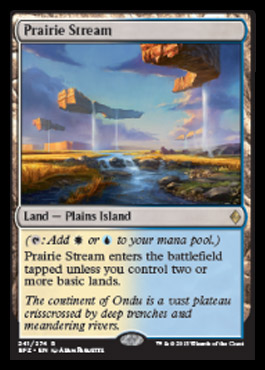
DJ Johnson: I’ll give Wizards some credit here. I think they did a great job designing fetchable dual lands that were playable in Standard, but wouldn’t rip Modern and Legacy apart. I still think you want to play shocklands over these almost all of the time in Eternal formats (When do you ever want to have two basics in play in Legacy before you fetch for your dual land?), but they should have legs in Standard which is all they need to be worth pulling from packs. If these ever go below $5-6 then I think you buy in, but I would sell them at the pre-sale hype. SCG is preselling the UW, GW, and UB ones for $10, and the GR/BR ones at $8. I think that’s a little bit high, but if you’re going to want these to play immediately during the first week of the set release then I wouldn’t scold you too hard. I think these are way better in Standard than Eternal, and their price will reflect that.
Jason Alt: I have reversed my position somewhat on these. I was trying to evaluate these in terms of Glacial Fortress, Seachrome Coast and Hallowed Fountain and nothing works as an analog. These are worse than Seachrome and Fountain, and the same as Fortress on turn 1. But these are better than all of them if you have a fetchland. With no Preordain, will the UB and UW be the best since you don’t care about your early land drops as much as aggro colors? What presale price do we like these at? Could these be $15 non-mythics in a set with so many good mythics and redemption enforcing low prices as well as the scramble for the “expedition” cards? I like these under $8 presale, especially to play with, but if these start at $15-$20 I’m not sure what to tell you. I need to hear from more players, but these could be insane. They’re worse in Standard, though, than they are in Modern so that could affect things a bit.
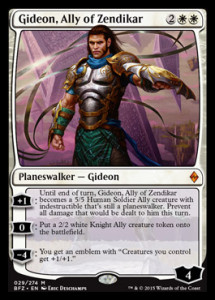
DJ Johnson: I think it’s funny that when they spoiled the picture, I waited for about five seconds to see the “other side” of it, because I’m somehow used to having double-sided planeswalkers now. Well, this is certainly a competitively costed Gideon, and he reminds me a lot of Elspeth, Knight-Errant. You trade the +1 for a 0, but you get 2/2 Knight Allies instead of Soldiers, which is certainly relevant. I don’t have my hopes up about Tribal Ally being a thing in Standard or Modern, but I do think Gideon finds a home in multiple shells over the next year and a half. I love that the emblem can be created multiple times, so you’re probably fine running 4x these guys if he really does end up being that good. Don’t buy in early because of good old Planeswalker hype, but don’t let him drop too far below $15 without having your finger on the “Buy” trigger either.
Jason Alt: Would it sound hyperbolic if I called this the best Planeswalker since Liliana? It’s certainly the best one since Elspeth’s last incarnation and I argue it does more and does it sooner. They have made so many stupid Gideons over the years, it’s good to see one I like. One of the only things keeping this under $40-$50 initially would likely be how good the rest of the set it. People tend to overvalue Planeswalkers so I have been talking to white players and they agree this is savage. Unfortunately, I don’t think there is as much money to be made in correctly evaluating a walker as there is to be lost in doing it incorrectly. I think what makes this unique is the stackable anthem which lets you run multiple copies. This will likely presell for so much that there is no money to be made unless you pack and flip them, but be aware that this seems quite good. A lot of people are predicting this stabilizes around $10-$15 but I’m not convinced, yet. I want to see some pros weigh in.
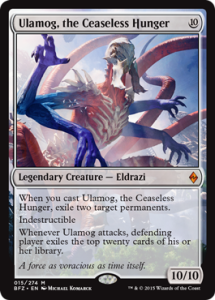
DJ Johnson: Alright, so this is how they decided to fix “Annihilator” while still making the titan trio feel like they were, well, annihilating you. It’s important to note that this time Ulamog can be reanimated, although you won’t get to Utter End twice if you do. He’s still indestructible, and 20 cards is a lot. Oh, right. I’m here for finance talk, not to mention how this is probably going directly into my Glissa EDH deck. These are going to pre-sell for a lot right off the bat, but I would wait to buy in until some of the hype dies down. I’m not sure where I feel the buy-in point is, but I think it has the legs for Standard. This is the kind of thing you want to jam into a See the Unwritten deck, and those are still sitting at around $5…
Jason Alt: Oblivion Sower threw me off track for sure. This is absolutely fine to cheat in with See the Unwritten despite not getting the cast triggers. No one complains about not getting an extra turn when they Show and Tell an Emrakul and I expect similar results here. This Eldrazi is what we wanted to see, it’s powerful yet unique enough that players can pick the eldrazi they want in their non-Standard decks based on the effect now that there will be more. This guy will be expensive. Will he be nuts long-term like the others? Hard to say, but I think you want to pack these and they’re giving us lots of reasons to buy boxes.
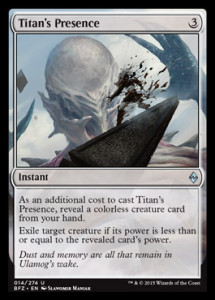
DJ Johnson: There will be casual players looking to build unsleeved Eldrazi decks that are solely composed of basic lands the cards with Eldrazi in the picture from the new set. This is going to be one of the uncommons they want in their decks. Pick them out of bulk, and have them on hand to sell at $.50 each.
Jason Alt: Solid. This is playable removal. I could see this getting played in Limited with the amount of colorless creatures we’ve seen. I imagine you can pick these out of chaff and jam them in a box and it’s possible (though I don’t know how likely) that the foils could be a play, but I’m not betting money on it. The card is too narrow and there is too much good removal already. Removal like..
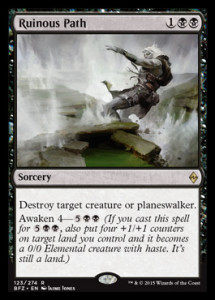
Jason Alt: … like this guy. Wow. Sorcery speed is rough so I don’t know this will quite be Hero’s Downfall money (which is fine) but the additional upside of the Awaken cost making a formidable beater from a land could make this playable even as a sorcery. This is obviously nuts in Limited but do we want a 3 mana, sorcery-speed terror in Standard when we lose Downfall? I like this below $4 but not that much.
DJ Johnson: Hero’s Downfall was just too good at Instant speed, I suppose. However, this scales into late game much better. If you have eight mana available, you get to remove an opposing blocker and crack back for 4, or have a blocker of your own at the ready. This is the kind of card that has the correct mana cost and power level to see Constructed play, so keep your finger on the pulse of this one. If it presells at $2-3 a piece, I think it’s a very strong card to buy into. I wouldn’t touch it at $5+ though.
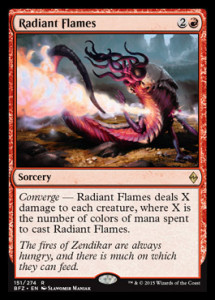
DJ Johnson: Anger of the Gods was just too good at in- wait, what? This isn’t even… ugh. Whatever. Having to put effort into making a red sweeper remotely playable kind of stings, especially when Anger was an all-star in multiple formats at various points and barely broke $3 consistently. If the format is ripe for a mediocre Pyroclasm then be ready to sell these off for the bulk-$1 that they end up at. Seriously, what was so bad about Anger of the Gods?
Jason Alt: “What if we jam an extra keyword ability into the set by taking an older keyword ability and barely changing it?”
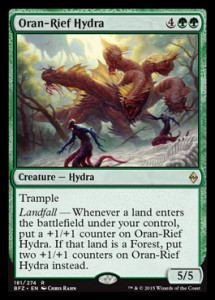
DJ Johnson: Buuuuuulk rare. I doubt even hydra lovers will love this one. Avenger of Zendikar and Rampaging Baloths are just far superior landfall triggers.
Jason Alt: Too many hydras. This doesn’t make the cut in a hydra deck, probably. There are too many good hydras that give us triggers when they die to trifle with this. Limited bomb, but bulk rare.
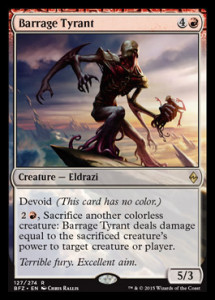
DJ Johnson: This is a really bad Fling. If you want to kill someone with Blightsteel Colossus that badly, paying 5 mana for a 5/3 and then an additional 3 mana is not the best way to go about it. This is just sad, honestly. Bulk rare.
Jason Alt: I look at this and think about how overcosted I thought Arc Slogger’s ability was. I wonder if I’m being too hasty to dismiss this card. Then I remember like 6 cards from every set impact Standard. If this were a Legend it would be a bad Bosh. This isn’t. I know it’s fine to get value from dying creatures but this is hella narrow. It can’t even suicide bomb itself. I’m going to pronounce this bulk.
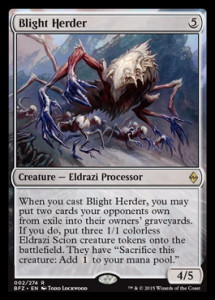
DJ Johnson: Well at least this is a little bit interesting. There are very few cards in the game that return exiled cards to the graveyard, but that’s also a pretty big drawback. At least the tokens (now they’re “Scions” instead of “Spawns” have power *and* toughness this time, so you’re getting seven power for 5 mana if you give your opponent back some of their Ingested cards. Still, this doesn’t get me nearly as hyped as It That Betrays did back in the original Zendikar block. The Eldrazi are a lot more toned down this time, so I don’t see Blight Herder going past bulk rare status.
Jason Alt: I’m not sure I would want to pay 5 mana for a 4/5 and 3 eldrazi spawn even if I don’t have the drawback of having to have hit them with a little bit of ingest, first. OK, that may be hyperbolic. That would be a fine rate. But this is pretty useless if you can’t ingest first or get them to exile stuff somehow. I’ll pass.
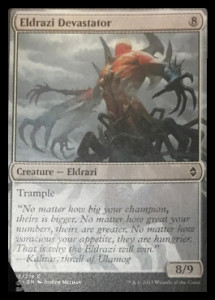
DJ Johnson: For all you Pauper enthusiasts out there, you now have a curve topper that beats Ulamog’s Crusher in a strict 1v1 duel.
Jason Alt: Aww, today we learned WotC thinks annihilator is equivalent to 1 extra toughness and having trample.
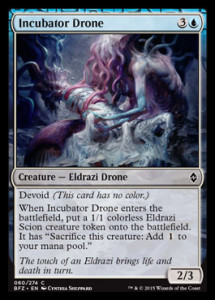
Jason Alt: This card is probably playable in your 40 in some builds but I’m mostly just glad I correctly guessed we’d get Eldrazi Spawn in the set
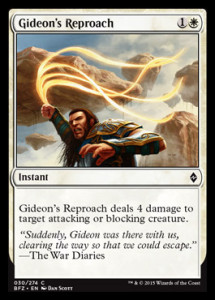
Jason Alt: Essentially this a a cheaper Neck Snap for non-Eldrazi. This will be OK in limited.
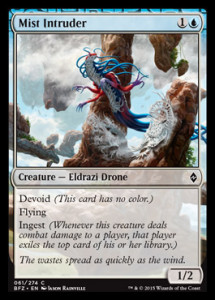
Jason Alt: I haven’t seen a ton of fliers, this is aggressive, kills 1/1 fliers and is devoid so it triggers colorless-specific stuff. Playable in your 40.
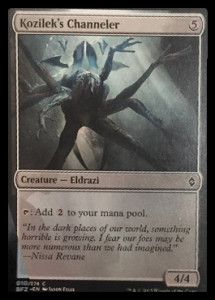
Jason Alt: I don’t know when to take this in draft but you almost certainly take this. Going from 5 mana to 8 in a turn is a big leap. It’s not great early, but 8 mana takes forever in Limited and this helps a ton. It’s also colorless, which matters in some builds.
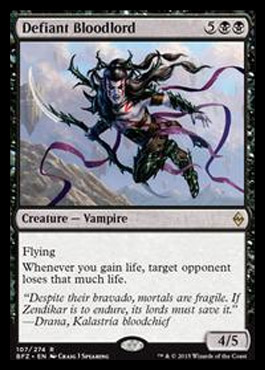
DJ Johnson: Sanguine Bond on a stick. As Jason stated above, the first reference that comes to mind is Butcher of Malakir. Grave Pact is a $8 rare with a billion printings, but the Butcher is a bulk rare. Sanguine Bond is a $1 rare with a billion printings, so this isn’t going to be making any waves either. Maybe it sees $1, but don’t get your hopes up. Play it in EDH if you really need the second Sanguine bond, but that’s about it.
Jason Alt: Defiant Bloodlord is to Sanguine Bond as Butcher of Malakir is to Grave Pact. I don’t know how much I like this as a potential curve-topper in a Standard vampires deck (this has nothing on Malakir Bloodwitch) but this is a potential EDH favorite if only as a second Saguine Bond. Serve in the air while you annoy your opponent with how uninteractive Oloro is. 7 mana is a lot outside of EDH which likely relegates this guy unless Standard slows down so much we don’t even recognize it anymore. This is too slow for Limited. I don’t know how much EDH can buoy this price if it’s non-mythic.
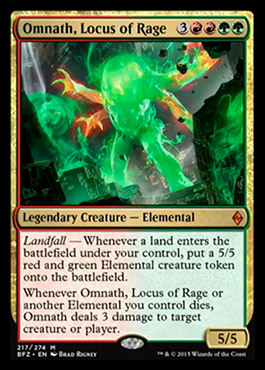
DJ Johnson: Omnath has been working out and juicing up. This is one of the most impactful Landfall triggers we’ve seen, as even Rampaging Baloths only handed out 4/4s. Now we get Wrath insurance if they decide to take out the army of Elementals that you created, but I don’t know if that’s enough to push it into Standard. I’m here to tell you about how much I think the card will be worth, and $4 a month after the set release seems about right, maybe even lower. I really don’t think this is gong to be a 4x in Standard anytime soon.
Jason Alt: Omnath Locus of HYYYYPE. This card is a lot of fun and will smash faces as your commander. People are speculating this could see Standard play but regardless of whether that pans out, this is a build-around EDH general for the ages. We’re already brewing combos with this as your general and stuff like Perilous Forays and Earthcraft and Amulet of Vigor are insane. Expect foils to be nuts initially – check the price trajectory of other obvious EDH generals like Narset to see when to buy in. I’ll likely do my weekly article about this card.
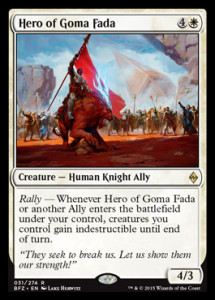
DJ Johnson: 4/3 for 5 mana seems like an awkward ball of stats that’s going to die in response to the ETB trigger from a single Lightning Bolt-esque effect. If it were costed more effectively then it would be an effect I could get behind, but this is not going to see any competitive play. I doubt it will even make it into the tier 2.5 Ally deck that may or may not exist later on in the block. Buuuuuulk Raaaare.
Jason Alt: Eh. It’s Kabira Evangel but without the whole “unblockability” angle. Is it just me or are the mana costs hella high on every card in this set? This is 4W which is too much to pay for an ally when we still have turn 2 Raksaha Deathdealer as a thing. This could be a 1-of or 2-of in an allies deck best case scenario which makes this expensive, narrow and non-mythic. Even if it sees play it won’t see $3.
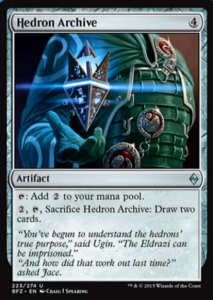
Jason Alt: This card may not impact Standard – I have no idea how people will feel about weird mana rocks when we haven’t seen really expensive Eldrazi, yet. This card, however, is NUTS in EDH. Mind Stone is already a staple in a lot of decks, especially red and white and combinations that have basically no card drawing. Mana ramp early when you need it and card drawing late when you run out of gas is superb. Compared to Thran Dynamo, this seems like a great fit for a lot of decks. Getting fewer mana than Dynamo makes this seem more like Sissay’s Ring, a nigh-unplayable card, but if you assess this as a Mega-Mind Stone, you can see the appeal. I imagine foils of this will be worth roughly five times as much as the non-foil and I plan to trade for these aggressively. If you don’t play EDH, trust me; this is a card. Non-foils are worth pulling out of draft chaff and boxing for a year or two and foils will get there even sooner. Good card is good. Exciting set is exciting.
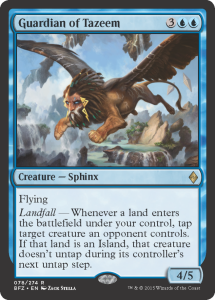
DJ Johnson: Guardian of Tazeem carries a pretty interesting spin on Landfall, referencing basic land types. I’m sure that we’ll see more of this type of effect for each basic land type, although I don’t think that this particular card is a warning shot for new Shockland-esque non-basics in the near future. Financially, there’s nothing to see here. This card is a bulk rare, through and through.
Jason Alt: It’s interesting to see “flavored” landfall – landfall that cares about the land you used to trigger it. If any of these types of cards are playable in Modern, this could give additional upside to Shocks, but they are pretty strong already. This card is obviously Intro Pack Rare tier but we can glean the landfall mechanic getting a twist and there could be a cycle at mythic or just a really good rare. Maybe a Lotus Cobra variant that gives you the color of mana that the land you played could produce? There is a lot of design space. While this card is only good in limited, the mechanic makes me want to go in on Animists’ Awakening.
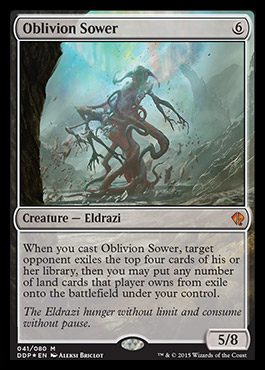
DJ Johnson: While the design of the card is certainly unique, I really don’t think it’ll see a whole ton of competitive play, if any. SCG is selling Duel Deck copies at $4, and I think that’s a perfectly natural price for the first few weeks of the set’s release. After a while, it’ll die down and hover in between “bulk mythic” and its’ current $4 price tag. I think $2 is reasonable, especially with the extra copies that will be in circulation. I’d be happy to sell any copy at that price, and then buy them for $.50 from everyone several months down the road.
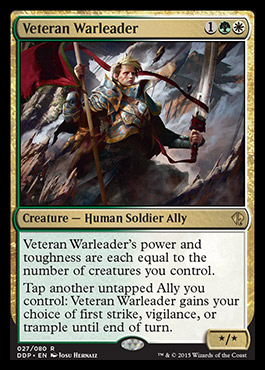
DJ Johnson: Allies are cool and all, but I still can’t see them having any financial relevance. The closest we got to Allies being worth anything was $1, and we’ve seen Jwari Shapeshifter creep back towards that $1 price tag in expectation of some Ally tribal deck being relevant. If you can sell these off ASAP, I’d agree with that battle plan. While these will always sell quickly to non-competitive players, I don’t see reason to buy in unless you’re paying literal dimes.
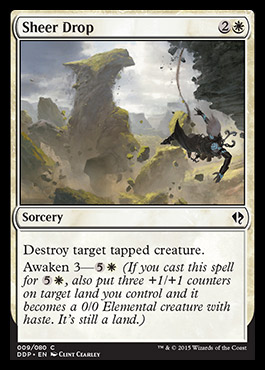
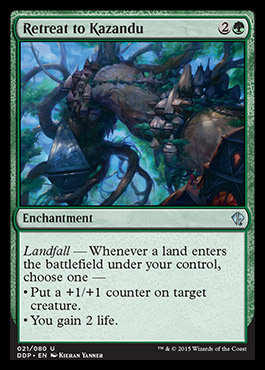
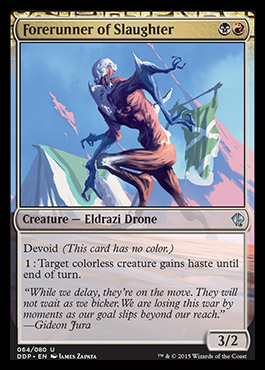
DJ Johnson: This is probably going to be one of the uncommons that I pick out of BFZ. It certainly has the stats to see play in competitive, and it’s pretty versatile on the curve. If we see any other Devoid creatures that can fill aggressive spots in a RB deck, this guy could end up being worth buylisting.
